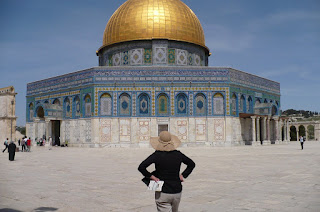

Here, we're sitting out on the veranda, drinking herb tea and eating our apple cake, mustering our energy for our 3 hour drive to Jerusalem. :)

For our two nights in Jerusalem, we stayed in a convent....the convent of the Sisters of the Rosary which we were told was a Middle Eastern order. This was their chapel:


Some sights from our day in the Old City: First stop, the Western Wall, the only remnant of the Temple. Here are the signs at the entrance of the plaza. I didn't realize that Jews believed that the presence of God was still here, dwelling in the vestiges of the Temple. That is not my belief but I was pretty awed by the idea that God once dwelled here, plus it was very interesting to watch others as they rocked back and forth, weeping or chanting the Torah or Mishnah quietly to themselves, and then backing away from the wall by walking backwards....not wanting to turn their backs to the presence of God.



As you can see from the first photo, the men and women are partitioned at the wall. On the men's side, there was a group holding hands in a circle and singing, I'm guessing it was a bar mitzvah. The women's side was less boisterous with each preoccupied with her own thoughts and prayers.




Our next stop was in the Christian quarter of the Old City. We stopped by the Lutheran Church of the Redeemer, built by Kaiser Wilhelm II, who came to dedicate it in person in 1898. We climbed up the bell tower for some wonderful views of the Old City around us. The first photo shows the spartan interior of the church; the second shows a view of the Dome of the Rock, on top of the Temple Mount, with the Mount of Olives and Garden of Gethsamene behind it.


Next stop, just a block away, was the Church of the Holy Sepulchre, which some people believe was the place Jesus died on the cross and was buried. There are six different denominations who control various sections of the church and there have been so many squabbles that back in the 1800s, there was an agreement on who controlled what and which areas were common areas. It was agreed that nothing could happen in any of the common areas without the agreement of all six parties. This has created a fragile stability, a thinly-veiled status quo which erupts with just the smallest incident. A small example of this happened in 2002 when a Coptic monk moved his chair from the sun into the shade which was in the Ethiopian Orthodox section. This was viewed by the Ethiopians as a hostile encroachment, a fistfight broke out, and eleven were hospitalized.
This photo shows another example. See the ladder under the second-story window?? Someone placed that ladder there before the common areas were established in 1852. Once the doors and windows were deemed common areas, the sects will not agree that the ladder should be moved....a powerful and sad symbol of how religion can be an obstruction to God.

The church is a dark, confusing mishmash of structures and styles, again, a sad human testament to the what is arguably the most important event in human history.



Then Art and I left Suzy and David at an Armenian restaurant in the Armenian quarter and walked up to the Temple Mount. The Temple Mount is controlled by Moslems and they only allow non-Moslems on top for a few hours each day. The Dome of the Rock is stunning and, yes, that's real gold. I asked if we could enter but was politely told it wasn't open to non-Moslems. It would have been neat to see the rock, but it was enough to see the dome up close and also to be up on the mount where the temple used to be.

We walked through the Moslem quarter, along the Via Dolorosa, back to join David and Suzy. The first photo is the Via Dolorosa and the second is a remnant of the Tower of David, part of Herod's palace complex. An amazing day.


































